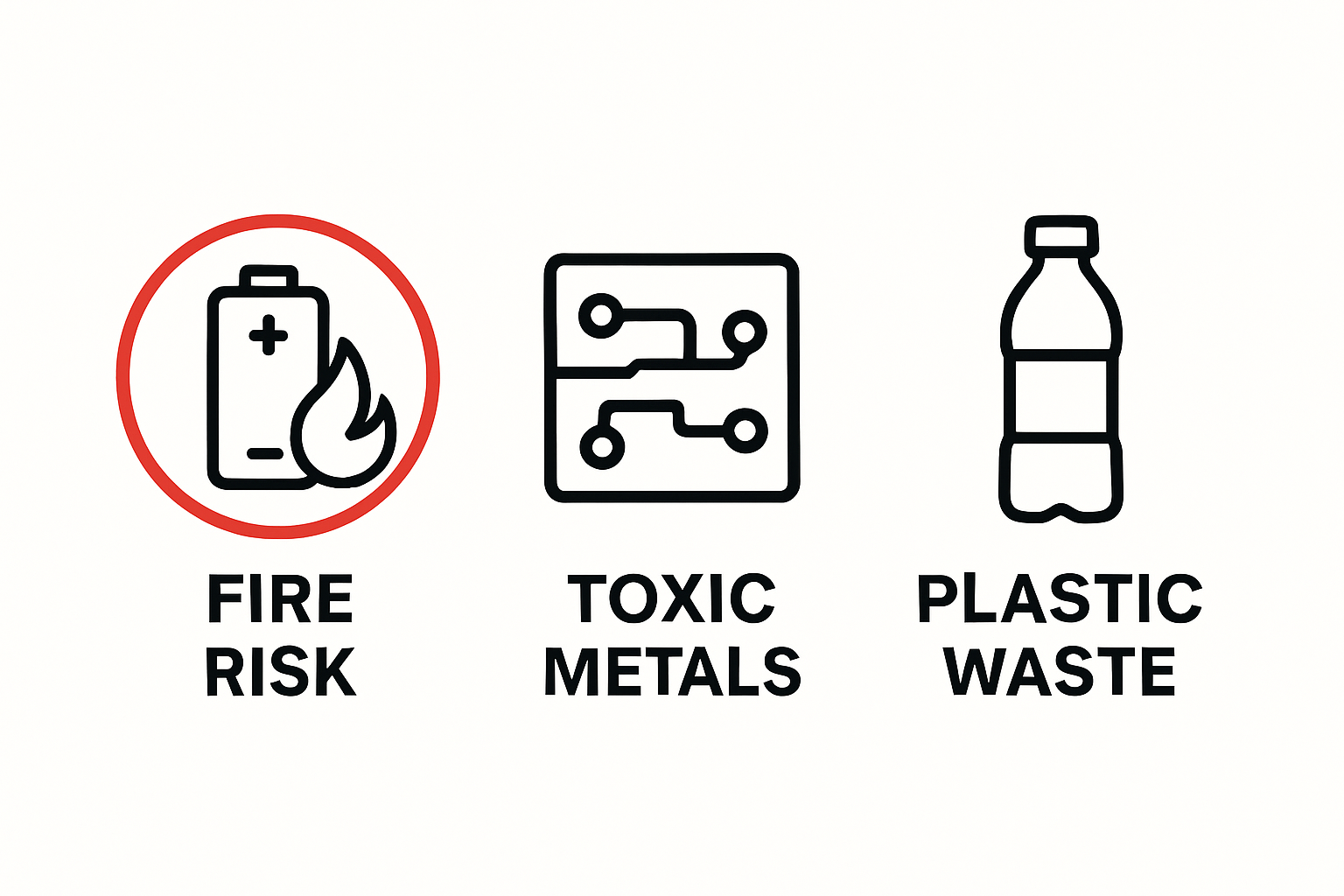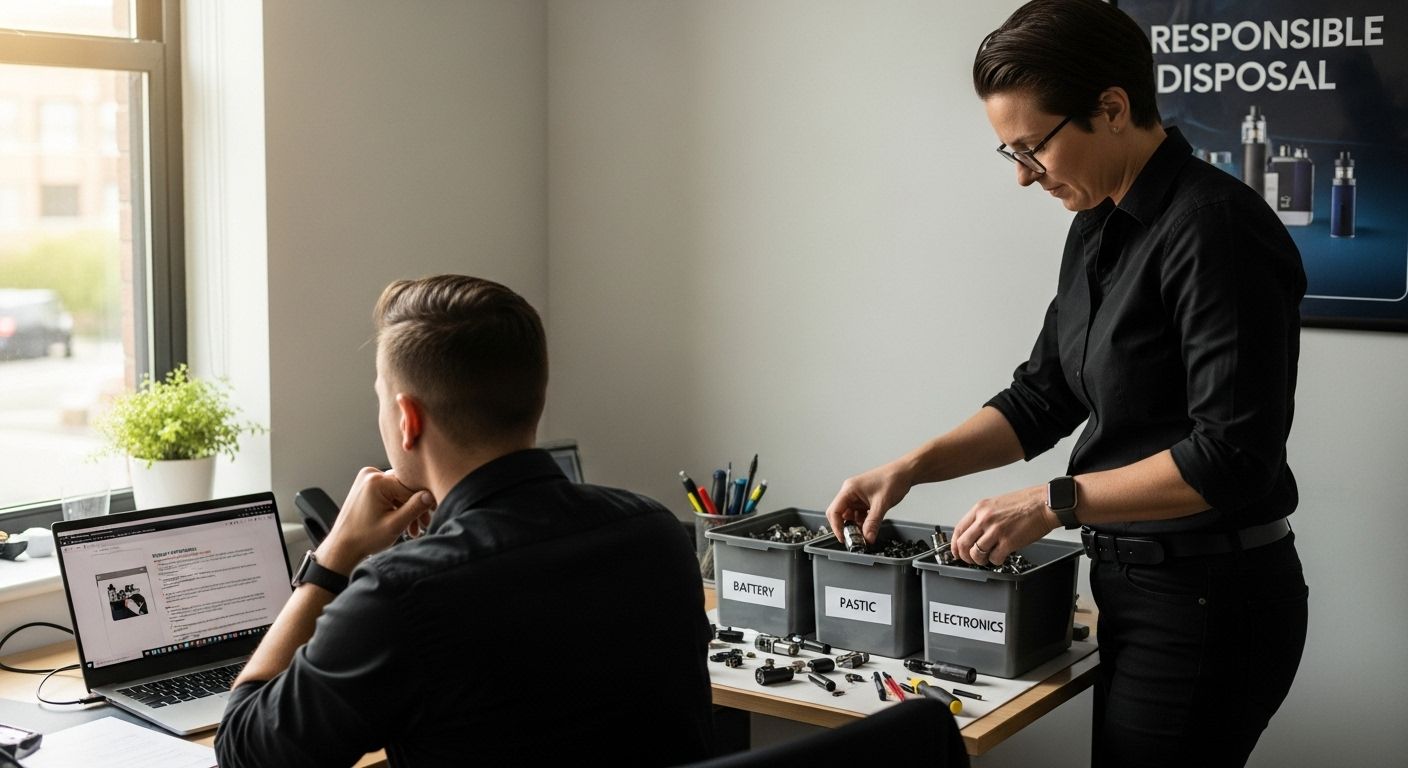Blog
What is Safe Disposal Vape? Understanding Responsible Practices
Safe disposal of vape devices is not just about making trash disappear. The shocking reality is that each improperly discarded device can release hazardous waste that threatens our soil, water, and public safety. What most people miss is that throwing a vape in the regular trash is never harmless and can actually spark fires or leak toxic chemicals into our communities.
Table of Contents
- Defining Safe Disposal Vape: What Does It Mean?
- The Importance of Safe Disposal for Vaping Products
- Understanding the Environmental Impact of Vape Waste
- Best Practices for Safe Disposal: Key Concepts to Know
- Navigating Regulations and Community Guidelines on Vape Disposal
Quick Summary
| Takeaway | Explanation |
|---|---|
| Proper disposal is essential for vape safety | Improper disposal can lead to environmental contamination and health risks for communities and waste management workers. |
| Use specialized disposal channels for vapes | Traditional waste streams are inadequate; utilize certified e-waste recycling centers or manufacturer take-back programs for safe disposal. |
| Vape components are classified as hazardous waste | Many parts of vape devices, including batteries, contain hazardous materials and require specific disposal protocols to protect the environment. |
| Understand local disposal regulations | Regulations vary by jurisdiction, and following local guidelines is crucial to ensure legal and responsible disposal practices. |
| Engage in community disposal initiatives | Participating in local e-waste collection events and educating others fosters collective responsibility and better waste management practices. |
Defining Safe Disposal Vape: What Does It Mean?
Safe disposal of vape devices represents a critical environmental and health responsibility for users. When we discuss what is safe disposal vape, we are addressing the systematic process of properly discarding electronic vaping devices to minimize potential ecological and safety risks.
Environmental and Safety Considerations
Understanding safe disposal goes beyond simply throwing away a used vape device. Responsible device management involves recognizing the complex components within these products. Vape devices typically contain several hazardous elements that require specialized handling:
To help clarify the hazardous elements found in vape devices and their potential risks, the following table summarizes the main components and associated dangers discussed in the article.
| Vape Device Component | Example | Environmental or Safety Risk |
|---|---|---|
| Lithium-ion Battery | Power cell | Fire hazard, chemical leakage |
| Electronic Circuit Board | Internal microchip | Toxic metals contaminating soil/water |
| Residual Nicotine Substances | Liquid/nicotine | Environmental harm, chemical pollution |
| Plastic and Electronic Parts | Casing/housing | Non-biodegradable, persistent pollution |

- Lithium-ion batteries that can pose fire risks
- Electronic circuit boards with potential toxic metals
- Residual nicotine substances that are environmentally harmful
- Plastic and electronic components that do not decompose easily
The U.S. Environmental Protection Agency classifies many vape components as acute hazardous waste, underscoring the importance of proper disposal techniques. Simply discarding these devices in regular trash or recycling bins can lead to significant environmental contamination and potential safety hazards.
Comprehensive Disposal Approach
A comprehensive safe disposal approach involves multiple strategic steps. Users must understand that these devices are not standard waste products. Proper disposal requires identifying local hazardous waste collection sites, understanding device-specific recycling guidelines, and potentially participating in manufacturer or retailer take-back programs.
The goal is not just environmental protection but also preventing potential secondary risks like battery-related fires or chemical leaching into soil and water systems. Learn more about our commitment to sustainable vape practices.
By adopting responsible disposal practices, users contribute to broader environmental conservation efforts and demonstrate a commitment to sustainable consumption. Safe disposal is more than a personal choice it is a collective responsibility towards protecting our shared ecosystem.
The Importance of Safe Disposal for Vaping Products
The significance of safe disposal for vaping products extends far beyond simple waste management. It represents a critical intersection of environmental responsibility, public health, and individual consumer awareness. Properly managing vape device disposal is not just an optional practice but a necessary action with wide-ranging implications.
Environmental Impact Considerations
Vaping products contain complex materials that can cause substantial environmental damage if improperly discarded. Research from the New Hampshire Department of Environmental Services highlights the multifaceted risks associated with incorrect disposal. These devices are not ordinary waste and require specialized handling:
- Lithium-ion batteries that can trigger chemical contamination
- Electronic components containing potentially toxic heavy metals
- Plastic materials with extended decomposition periods
- Residual nicotine substances that can harm ecosystems
The environmental consequences of improper disposal can be profound. When vaping devices enter standard waste streams, they introduce hazardous materials into soil, water systems, and potential recycling processes. Each improperly discarded device represents a potential ecological threat.
Health and Safety Implications
Beyond environmental concerns, safe disposal addresses critical health and safety risks. Improperly managed vaping devices can create potential hazards for waste management workers, residential communities, and broader public infrastructure. Lithium batteries embedded in these devices pose significant fire risks when crushed or exposed to extreme temperatures.
Explore our sustainable vaping solutions that prioritize responsible consumption and disposal. Consumers play a pivotal role in mitigating these risks by understanding and implementing proper disposal protocols.
Ultimately, safe disposal is a shared responsibility. It demands awareness, intentional action, and a collective commitment to protecting our environment and community health. By treating vaping products as specialized waste, we demonstrate respect for ecological systems and public safety.
Understanding the Environmental Impact of Vape Waste
Vape waste represents a growing environmental challenge that extends far beyond typical consumer electronics disposal. As vaping technology becomes increasingly prevalent, understanding its ecological footprint becomes crucial for responsible consumption and waste management.
Composition and Contamination Dynamics
Research from the International Journal of Environmental Research and Public Health reveals the complex environmental risks associated with vape device waste. These devices are not merely simple electronic components but intricate systems containing multiple hazardous materials:
- Lithium-ion batteries with potential chemical leaching capabilities
- Electronic circuits containing rare earth metals and toxic compounds
- Plastic casings that resist standard biodegradation processes
- Residual nicotine and chemical residues that can contaminate soil and water systems
The cumulative environmental impact of improperly disposed vape devices can be substantial. Each discarded device potentially introduces multiple contaminants into ecological systems, creating long-term environmental challenges that extend well beyond immediate disposal.
Waste Stream and Ecological Disruption
The current trajectory of vape waste management represents a significant ecological concern. Unlike traditional electronic waste, vaping devices often contain concentrated chemical compounds that can rapidly degrade environmental quality. The intricate combination of electronic components, chemical residues, and non-biodegradable materials creates a unique waste management challenge.
Explore our sustainable vaping approach that prioritizes responsible product design and disposal. Manufacturers and consumers alike must recognize their role in mitigating these environmental risks.
Addressing vape waste requires a comprehensive approach that combines technological innovation, responsible consumer behavior, and robust waste management infrastructure. By understanding the nuanced environmental implications, we can develop more sustainable practices that protect our ecological systems while supporting technological innovation.
Best Practices for Safe Disposal: Key Concepts to Know
Safe disposal of vaping products requires a strategic and informed approach that goes beyond simply discarding devices. Understanding the nuanced process of responsible disposal is crucial for environmental protection and personal safety.
Preliminary Assessment and Preparation
Before disposing of any vaping device, users must conduct a comprehensive preliminary assessment. According to the U.S. Environmental Protection Agency, proper disposal involves several critical considerations:
- Completely drain all battery power from the device
- Remove any remaining e-liquid or cartridges
- Inspect the device for potential damage or leakage
- Separate electronic components from plastic and metal parts
Careful preparation is the foundation of responsible vape device disposal. Each step reduces potential environmental and safety risks associated with improper waste management.
The following table outlines the key steps and purposes involved in preparing vape devices for safe disposal as described by the article.
| Step | Purpose |
|---|---|
| Completely drain all battery power | Prevent electrical accidents and reduce fire risks |
| Remove remaining e-liquid/cartridges | Prevent chemical leakage and environmental damage |
| Inspect device for damage or leaks | Identify hazardous materials and avoid contamination |
| Separate components (plastic, metal) | Enable specialized and safe recycling processes |

Specialized Disposal Channels
Traditional waste streams are inadequate for managing vaping devices. These products require specialized disposal channels that can safely process complex electronic and chemical components. Consumers should prioritize:
- Certified electronic waste recycling centers
- Manufacturer take-back programs
- Local hazardous waste collection events
- Specialized battery recycling facilities
Discover our comprehensive disposal guidelines that simplify the process of responsible vape device management. Understanding these specialized channels ensures that potentially harmful materials are processed safely and efficiently.
Effective vape disposal is not just an individual responsibility but a collective environmental commitment. By adopting these best practices, users contribute to broader sustainability efforts and help mitigate the ecological impact of electronic waste.
Navigating Regulations and Community Guidelines on Vape Disposal
Vape disposal regulations represent a complex landscape of environmental, safety, and legal considerations. Understanding these guidelines is crucial for responsible consumers who seek to minimize ecological impact while adhering to local and national waste management standards.
Regulatory Frameworks and Compliance
According to the U.S. Environmental Protection Agency, vaping devices are not considered standard waste products. They require specialized disposal protocols due to their unique composition of electronic and chemical components. Key regulatory considerations include:
- Classification as hazardous electronic waste
- Specific battery disposal requirements
- Restrictions on standard waste stream disposal
- Potential local and state level variations in disposal guidelines
Compliance with these regulations is not optional but a legal and environmental necessity. Consumers must proactively understand the specific guidelines governing their local jurisdiction.
Community Engagement and Responsible Practices
Local communities are increasingly developing targeted approaches to vape waste management. These initiatives often involve collaborative efforts between municipal authorities, environmental organizations, and consumer education programs. Responsible disposal practices typically encompass:
- Participating in community electronic waste collection events
- Utilizing manufacturer take-back programs
- Supporting local recycling initiatives
- Educating peers about proper disposal methods
Learn more about our community-focused disposal strategies that emphasize collective environmental responsibility.
Navigating vape disposal regulations requires ongoing education, awareness, and a commitment to environmental stewardship. By understanding and implementing these guidelines, consumers play a critical role in creating sustainable waste management ecosystems.
Ready to Make Safe Vape Disposal Easy and Responsible?
If the challenges of disposing of vape devices safely feel overwhelming, you are not alone. Many find it hard to manage products that contain hazardous materials and complex electronics. The article outlined how improper vape disposal can hurt the environment and create health risks. At Shorties Disposable, we specialize in premium cannabis vapes that not only deliver quality but also help you act responsibly with clear, actionable disposal guidance.

Choose Shorties Disposable for quality you can verify and a commitment to transparency and sustainability. Explore our lab-tested solutions and recycling program for a safer, greener experience. Take control of your environmental impact and shop now for products that put your values into practice.
Frequently Asked Questions
What is safe disposal vape?
Safe disposal vape refers to the proper methods used to discard vaping devices and their components, ensuring minimal environmental and health risks.
Why is safe disposal of vape devices important?
The safe disposal of vape devices is critical to prevent environmental contamination and safety hazards, as they contain hazardous materials like lithium-ion batteries, toxic metals, and residual nicotine.
What are the best practices for disposing of vape devices?
Best practices include completely draining the battery, removing e-liquid, inspecting for damage, and using specialized disposal channels such as electronic waste recycling centers or local hazardous waste events.
What are the potential environmental impacts of improperly disposed vape devices?
Improperly disposed vape devices can introduce hazardous materials into soil and water systems, causing chemical contamination and harming ecosystems due to their complex materials that resist degradation.
Recommended
- Understanding Why Single Use Vapes Are Popular Today
- Understanding the Role of Safety Seals in Vapes
- Optimize Your Vape Maintenance Workflow for 2025 Success
- Understanding the Role of Flavor Profiles in Vapes

